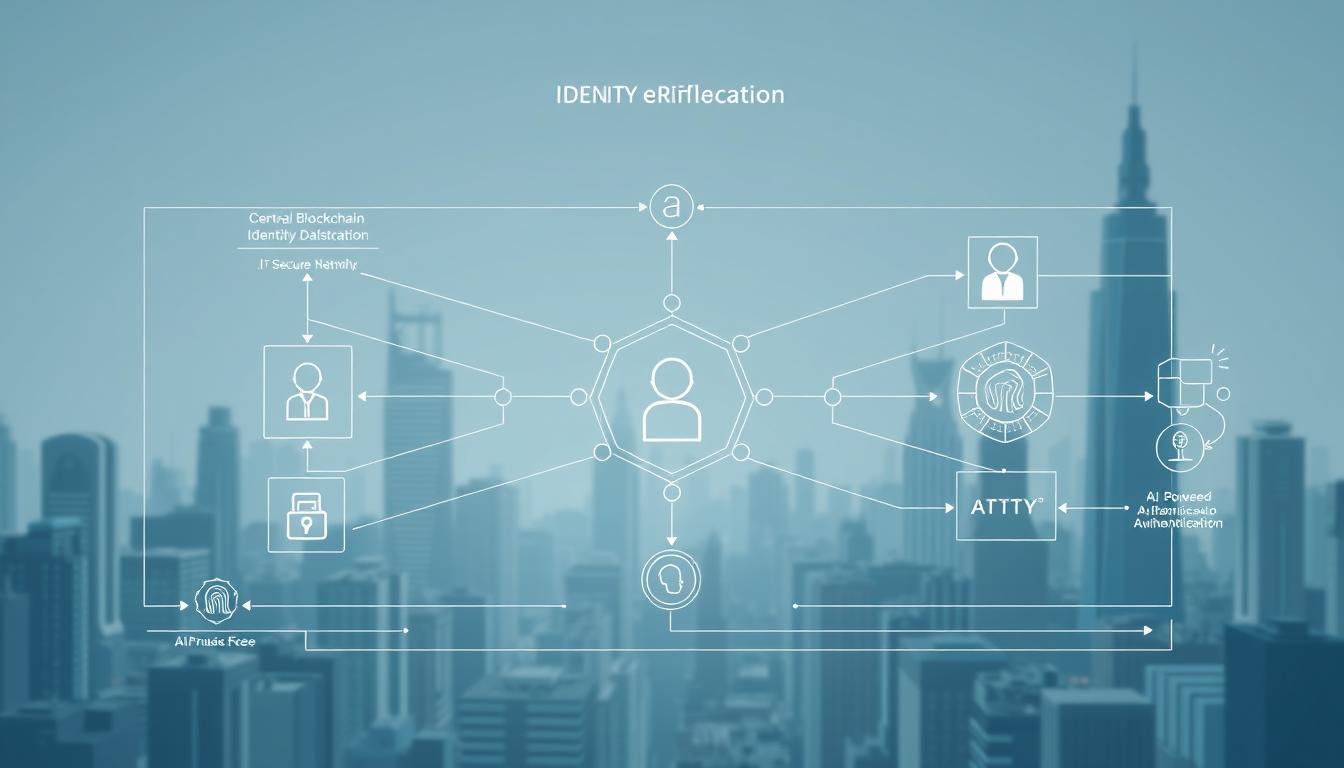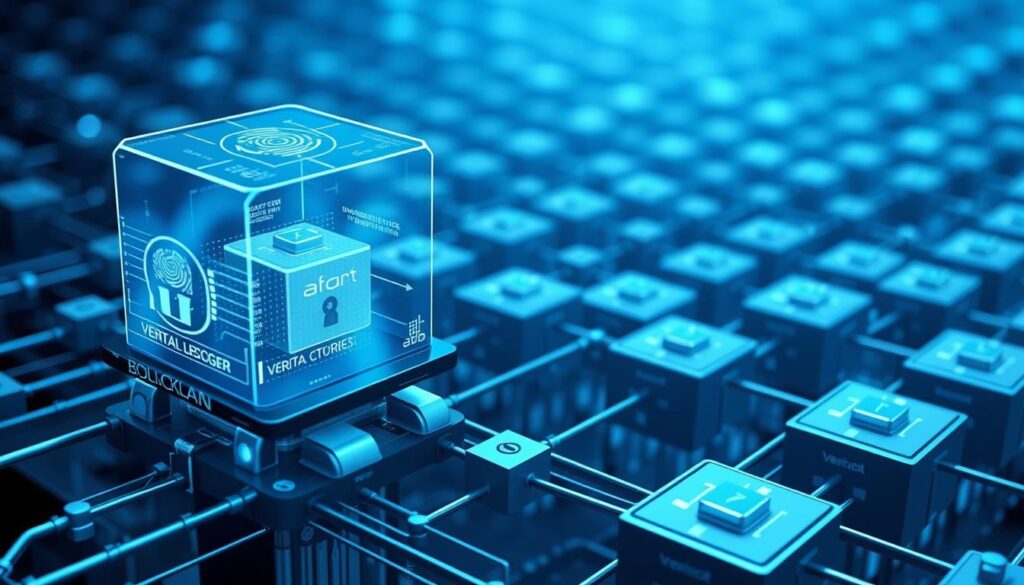Now Reading: How AI Blockchain Identity Verification System Works
- 01
How AI Blockchain Identity Verification System Works
How AI Blockchain Identity Verification System Works

In our connected world, protecting personal information is more critical than ever. Traditional methods for confirming who we are online often struggle with security risks and data breaches. This guide explores a powerful new approach that combines cutting-edge technologies.
This innovative solution merges artificial intelligence with blockchain’s secure framework. The goal is to create a robust process for managing digital identity. It tackles the core problems of privacy and unauthorized access that plague older models.
We will examine the core components that make this possible. You will learn how these elements work together to build a transparent and efficient framework. This represents a major shift toward user-controlled and highly secure management of personal data.
The applications span vital sectors like finance and healthcare. Understanding this technology is key to grasping the future of online security and trust.
Key Takeaways
- This guide explains a new method for securing digital identity.
- It combines advanced technologies to enhance security and transparency.
- The approach addresses critical weaknesses in traditional systems.
- You will learn about the core components and how they integrate.
- Real-world uses in finance and healthcare demonstrate its value.
- The system aims to reduce fraud and protect against data theft.
- It represents a significant shift toward user-controlled identity management.
Introduction to AI and Blockchain
Two powerful technologies are driving a new wave of digital innovation. Understanding their core principles is essential to grasp how they combine to create more secure and intelligent systems.
Overview of AI Technologies
Machines that simulate human intelligence rely on complex algorithms and learning models. These processes enable them to recognize patterns, solve problems, and make decisions from vast amounts of data.
Most practical applications today use narrow artificial intelligence. This type is designed for specific tasks, like analyzing documents or detecting anomalies. Its effectiveness stems from disciplines like computer science and mathematics, which form the foundation of knowledge engineering.
Fundamentals of Blockchain Technology
This technology operates as a decentralized digital ledger. Records are stored in blocks and linked across a network of computers. This structure ensures there is no single point of failure.
Every entry is secured with a digital signature, making the information tamper-proof. This cryptographic security builds trust among participants without needing a central authority. While famous for cryptocurrencies, its uses extend to creating transparent and accountable systems.
The potential of the fusion of these technologies is significant. Intelligent algorithms can optimize decentralized processes, while the secure ledger guarantees the integrity of the data they use.
Understanding the “AI blockchain identity verification system”
A revolutionary approach to managing online credentials combines machine learning with cryptographic security. This framework represents a significant advancement in how personal information gets confirmed digitally.

Core Components and Integration
The technical architecture relies on sophisticated pattern recognition algorithms. These work alongside distributed ledger technology for permanent record-keeping.
Cryptographic protocols ensure data protection and user authentication. The integration creates a unified framework that leverages both technologies’ strengths.
How AI Enhances Verification Processes
Intelligent systems dramatically improve confirmation accuracy and efficiency. They use facial comparison, behavioral analysis, and text processing capabilities.
Automated document collection and information extraction speed up the entire procedure. This minimizes manual errors while maintaining high security standards.
The distributed ledger provides a secure foundation for storing confirmed credentials. This creates an unchangeable audit trail that prevents unauthorized changes. For those interested in user-controlled approaches, explore self-sovereign identity concepts.
The Role of Decentralized Identity in Digital Verification
Modern approaches to online authentication are shifting power back to individuals. This new framework represents a fundamental change in how personal credentials get managed across digital platforms.

User Privacy and Data Control Benefits
Decentralized identity gives people direct ownership of their digital credentials. Users manage their personal information through unique identifiers and encryption keys.
This approach distributes data across network nodes, eliminating single points of failure. It significantly reduces vulnerability to breaches that affect traditional models.
| Feature | Centralized Systems | Decentralized Solutions |
|---|---|---|
| Data Storage | Single location databases | Distributed across network |
| User Control | Managed by organizations | Controlled by individuals |
| Security Approach | Centralized protection | Cryptographic techniques |
Decentralized Solutions vs. Centralized Systems
Traditional centralized databases create prime targets for cyber-attacks. They store vast amounts of sensitive information in single locations.
Decentralized frameworks allow seamless interactions across different platforms. Users provide explicit consent for data sharing, addressing major privacy concerns.
Smart Contracts and Distributed Ledgers in Identity Management
Self-executing code and shared ledgers provide the backbone for next-generation credential management. These technologies automate complex processes while ensuring robust protection.
Working Mechanisms of Smart Contracts
Smart contracts operate as automated agreements with terms encoded directly into software. They execute automatically when predefined conditions are met.
Platforms like Ethereum use programming languages such as Solidity. This enables creation of automated workflows for credential validation.
The contracts eliminate intermediaries from authorization processes. This creates efficient, transparent operations between various parties.

Importance of Distributed Ledgers for Security
Distributed ledger technology removes single point failure vulnerabilities. Data gets replicated across multiple network nodes instead of centralized storage.
Each participant maintains access to the complete dataset history. Collective validation ensures no single entity can manipulate information.
This approach creates tamper-proof audit trails for all transactions. It builds trust among users and organizations participating in credential processes.
Practical applications include automated validation workflows and secure data sharing. The technology provides resilience against fraud while maintaining transparency.
Real-World Applications of AI and Blockchain Integration
From financial services to healthcare delivery, integrated technological approaches are revolutionizing security and efficiency. These practical applications demonstrate how combined methodologies create tangible benefits across diverse sectors.
Use Cases in Finance and Healthcare
Financial institutions leverage intelligent pattern analysis to detect unusual transaction behaviors. This enhances fraud prevention while maintaining regulatory compliance.
Healthcare organizations protect sensitive patient information through advanced cryptographic methods. Medical records remain secure while enabling authorized data sharing between providers.

Preventing Fraud and Enhancing Security
Continuous learning algorithms monitor platform interactions in real-time. They identify potential threats before they can cause harm.
The immutable nature of distributed ledgers makes credential tampering nearly impossible. This significantly reduces risks of identity theft across various services.
| Application Area | Traditional Approach | Integrated Solution |
|---|---|---|
| Financial Transactions | Manual review processes | Automated anomaly detection |
| Medical Record Access | Centralized database storage | Distributed cryptographic protection |
| Identity Management | Password-based authentication | Biometric and ledger-based verification |
These solutions represent significant advancements in digital identity management. They deliver faster processes and stronger protection for users and businesses alike.
Challenges and Considerations for Implementation
While the benefits are significant, the path to implementation is paved with both technical and regulatory obstacles. Organizations must prepare for these potential hurdles to ensure a smooth and successful deployment.
Scalability and Integration Hurdles
One of the biggest tests involves handling growth. As user numbers rise, the underlying technology must process more requests without slowing down. Performance can suffer if the infrastructure is not designed for scale from the start.
Integrating new solutions into existing legacy frameworks is another major challenge. Compatibility issues often arise, requiring careful planning and potentially costly upgrades. The goal is a seamless connection that does not disrupt current operations.
These technical challenges demand robust solutions. Companies need to assess their current capabilities and plan for future expansion.
Regulatory and Compliance Issues
The legal landscape is complex and varies by region. Organizations must follow strict rules like anti-money laundering (AML) and know-your-customer (KYC) requirements. Navigating these different standards takes time and expertise.
Data privacy is a top priority. Protecting sensitive user information from breaches is essential for maintaining trust. Processes must be designed to meet high security standards across all jurisdictions.
| Consideration | Technical Focus | Business Impact |
|---|---|---|
| System Performance | Handling high transaction volumes | User satisfaction and service reliability |
| Legal Adherence | Data protection protocols | Avoiding fines and building trust |
| User Adoption | Intuitive interface design | Widespread acceptance and usage |
Success depends on addressing both the technical and human factors. Clear communication helps users understand the value and security of new services.
Future Trends and Evolving Technologies
Next-generation approaches to digital credential management are evolving at an unprecedented pace. The synergy between advanced pattern recognition and decentralized ledgers continues to reshape how personal information gets protected.
Innovations in Digital Identity Management
Emerging authentication methods combine multiple biometric factors with sophisticated analysis. This creates multi-layered security approaches that are both more secure and user-friendly.
The trend toward self-sovereign solutions gives individuals complete control over their digital identities. People can manage credentials across platforms while maintaining privacy through cryptographic techniques.
Global interoperability standards are developing to allow portable credential solutions. Verified credentials on one platform could be recognized across different services and jurisdictions.
These evolving technologies promise significant benefits including reduced fraud and enhanced user experiences. They offer greater individual control over personal information in our connected world.
Conclusion
Traditional approaches to credential management are proving inadequate in today’s interconnected environment. The integrated methodology explored throughout this guide represents a transformative advancement in securing digital presence against growing threats.
This approach delivers significant benefits including enhanced privacy through decentralized storage and cryptographic protection. Users gain greater control over their personal information while organizations benefit from more efficient processes.
Real-world applications across finance and healthcare demonstrate the practical value of these solutions. They address fundamental security challenges while building trust among all participants.
These innovative frameworks are reshaping how we establish confidence and protect sensitive data. They offer practical solutions for managing credentials in our increasingly digital world.
FAQ
What is a decentralized identity?
A decentralized identity is a form of digital identity management where individuals have direct control over their personal information. Instead of being stored in a central database managed by an organization, the data is held by the user and verified through a distributed ledger. This approach reduces the risk of large-scale data breaches and gives people greater privacy.
How does this technology improve security compared to traditional methods?
This approach enhances security by eliminating the single point of failure common in centralized systems. Information is cryptographically secured on a distributed ledger, making it extremely difficult for unauthorized parties to alter or steal data. Advanced authentication processes and security measures work together to significantly reduce instances of identity theft and fraud.
Can these systems help prevent data breaches?
Yes, by design, these platforms minimize the risk of large-scale data breaches. Since personal data is not stored in a central repository, there is no single target for attackers. The use of distributed storage and robust encryption means that even if one part of the network is compromised, the overall integrity of user identities remains protected.
What role do smart contracts play in the verification process?
Smart contracts automate the verification steps without needing a central authority. They execute predefined rules on the distributed ledger, streamlining authentication. This automation makes the entire process faster, more efficient, and reduces the potential for human error or manipulation.
Are there real-world applications for this technology today?
Absolutely. Industries like finance and healthcare are already implementing these solutions. Banks use them for secure customer onboarding, while hospitals employ them to manage patient records safely. These applications demonstrate the practical benefits of enhanced security and user control over personal information.
What are the main challenges for organizations adopting this system?
The primary hurdles include scalability to handle large volumes of users and integration with existing legacy systems. Furthermore, organizations must navigate complex regulatory and compliance issues to ensure their implementations meet legal standards for data protection and privacy.
How does this give users more control over their personal information?
Users manage their own digital identities through private keys, deciding exactly what information to share and with whom. This shifts control from organizations back to individuals, addressing major privacy concerns and fostering a greater sense of trust in digital interactions.















